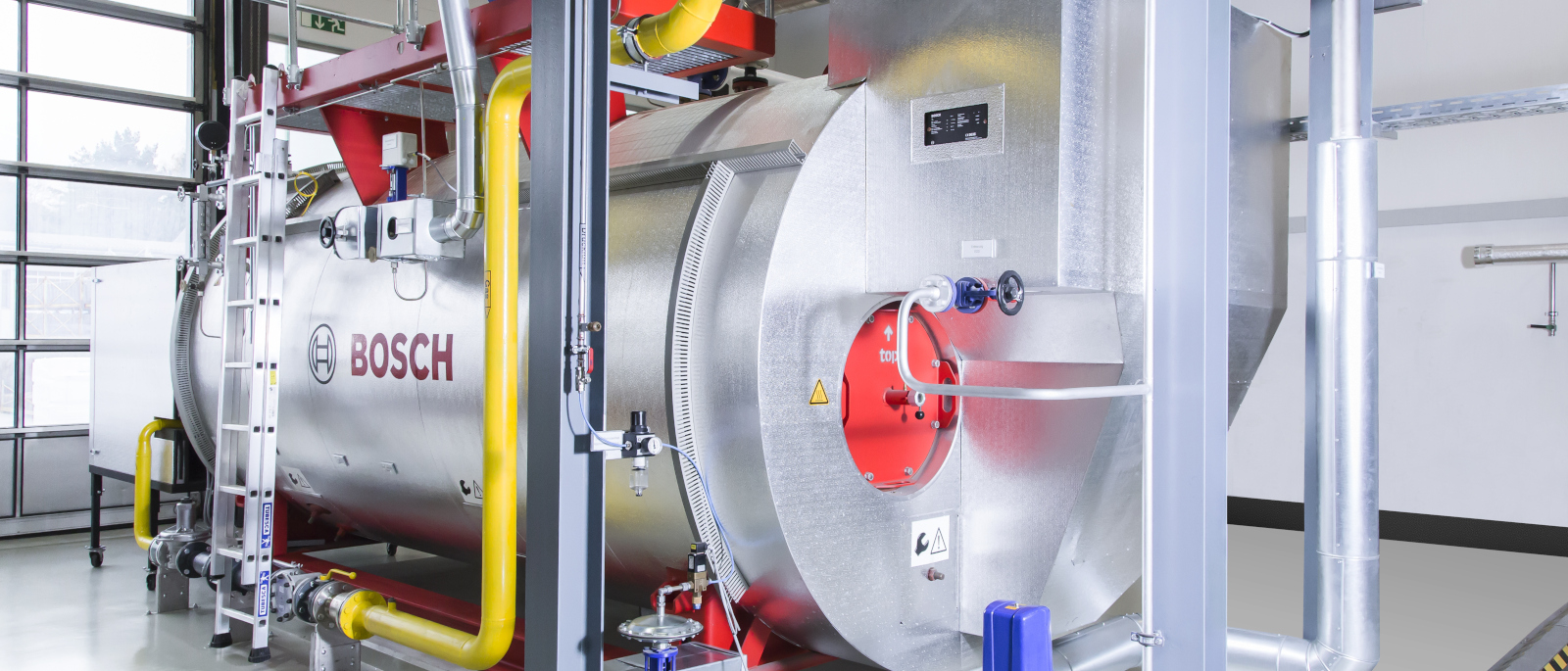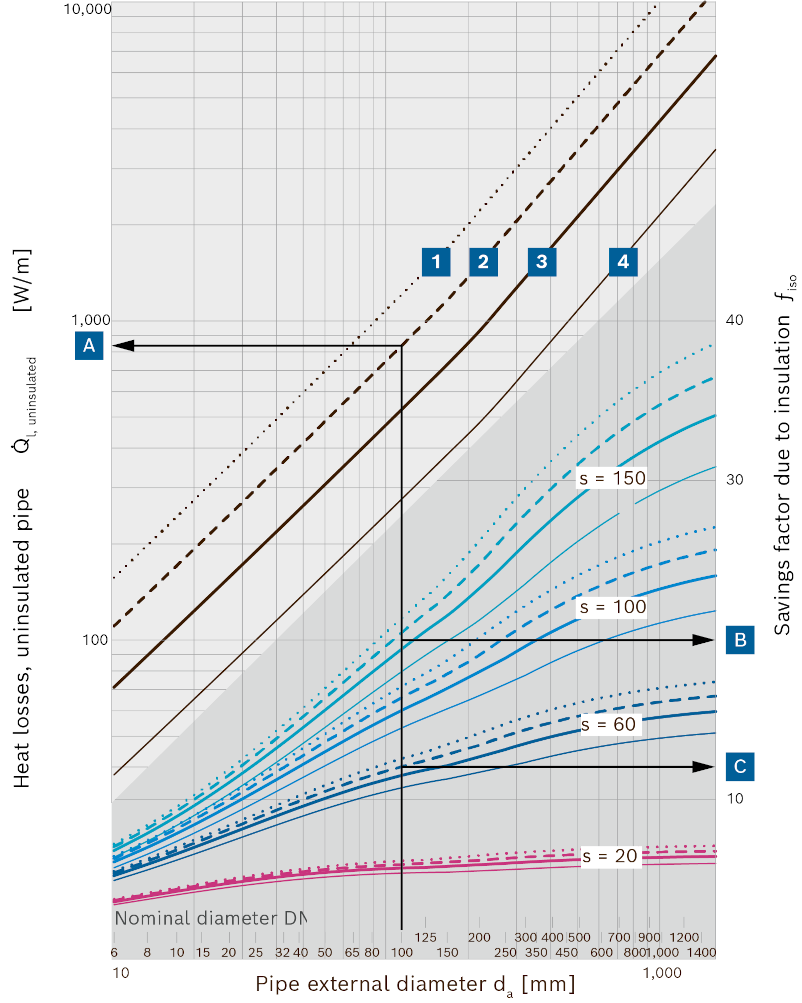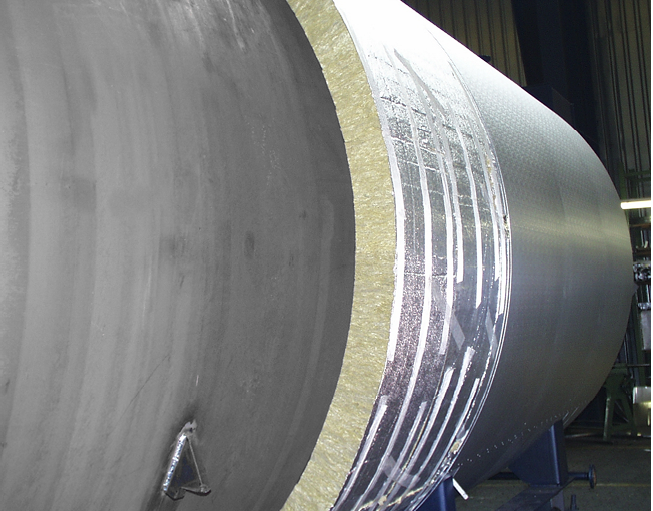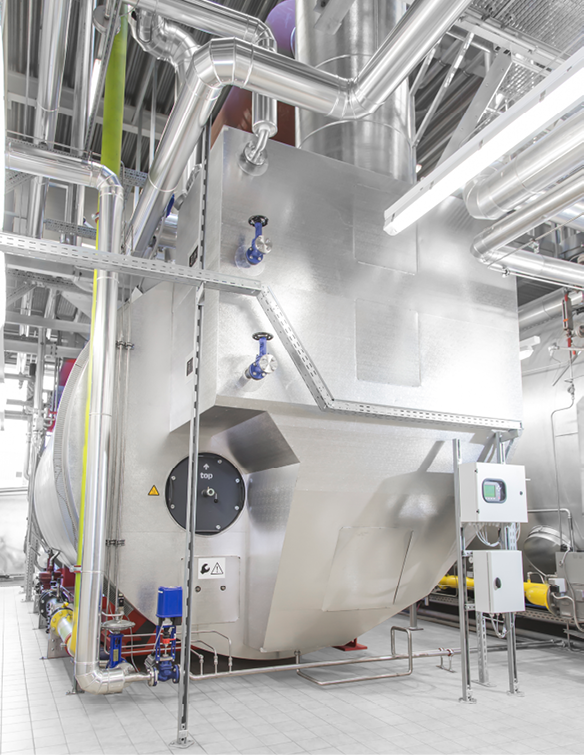
Increasing efficiency at the boiler and system
Insulation
The losses due to conductivity and radiation occur due to the temperature differential between the medium in steam boilers, lines and valves and the surroundings.
The extent of the heat losses essentially depends on the surface area, the medium, the ambient temperature and design of the insulation.
As these losses are not output-dependent, they occur continuously, also in downtime phases, and are therefore also present 365 days a year in systems or parts of systems that have not been taken out of service. They adversely affect the annual degree of utilisation of the boiler system, especially if the system is frequently operated in partial load.
Info on Annual degree of utilisation
In addition to a more time-consuming investigation using a thermal imaging camera, “hotspots”, or areas where the greatest heat losses occur, can be detected and eliminated by feeling out the hot areas, visual inspection of the insulation or by using a surface or radiation thermometer.
However, the surface temperature only reflects the degree of heat loss to a certain extent. Especially when comparing different surface materials, a low surface temperature is occasionally an indication of higher heat losses.
The reason for this lies in the radiation coefficient of the insulating surface. If the coefficient is higher, the heat losses increase but at the same time the surface temperature decreases. It is therefore advantageous to use a material with a low emission coefficient ε.
|
Example: |
|
|
Feed water vessel |
L = 3,600 mm, Ø = 1,700 mm |
|
Insulation |
T = 100 mm |
|
Medium temperature |
103 °C |
|
Surface material1) |
Emission coefficient ε |
Heat losses via |
Surface temperature |
|
Aluminium, plain-rolled |
0.05 |
627.5 W |
30.0 °C |
|
Aluminium, oxidised |
0.13 |
635.5 W |
29.0 °C |
|
Galvanised sheet metal, bare |
0.26 |
645.5 W |
27.6 °C |
|
Galvanised sheet metal, dusty |
0.44 |
655.5 W |
26.3 °C |
|
Austenitic stainless steel |
0.15 |
637.2 W |
28.7 °C |
|
Alu-zinc sheet metal, slightly oxidised |
0.18 |
639.7 W |
28.4 °C |
|
Nonmetallic surface |
0.94 |
671.2 W |
24.2 °C |
1) According to VDI 2055 Sheet 1 Appendix A8
The biggest heat losses in existing systems normally occur as a result of uninsulated valves, areas that have not been re-insulated following inspection or repair or thermal bridges formed when moving the protective insulation layer.
Most of the conduction and radiation heat losses in existing systems can be avoided by eliminating these “hotspots” without having to completely re-insulate the system. Insulation of uninsulated areas in the overall system (e.g. boiler, steam and condensate pipes, valves, tanks) is one of the most efficient saving measures in existing systems.
The heat loss at the boiler itself can also be easily determined in the idle state. The pressure drop can be determined once the boiler has been shut down (e.g. at the weekend) with the steam, surface blowdown and bottom blowdown valves closed. Starting with a steam pressure in the boiler of 10 bar, the pressure drop should be no more than 0.2 bar/h. It must be observed that not only the radiation and conduction losses must be considered, but also the ventilation losses due to the flue resistance (if applicable). The result may also be influenced by valves that do not close tightly.
However, the heat loss measured indirectly via the pressure drop is present independent of the cause, and should be avoided.
The efficiency of the insulation can be improved by observing the following points.
Insulation thickness and surface area
The surface temperature and heat loss can be reduced by increasing the insulation thickness. In this case however the aim is to choose an optimisation measure that is sensible and economical as the surface losses cannot by any means be halved simply by doubling the thickness of the insulation.
In addition to the insulation thickness, the size of the surface also plays a decisive role. Compact boiler types, e.g. with asymmetrical design, as well as an integrated economiser and resulting smaller insulation surface are advantageous in this respect.

Heat losses via the insulated area of the container or boiler surface
|
|
Medium temperature: 250 °C (. . . . . .) |
|
Medium temperature: 150 °C (_______) |
|
|
|
Medium temperature: 200 °C (- - - -) |
|
Medium temperature: 100 °C (_______) |
The figure above shows that with an insulation thickness of 100mm and a medium temperature of 150°C the heat loss is roughly 57W/m².
This falls by 30% to around 40W/m² when the insulation thickness is increased to 150mm. The heat loss can be reduced by 44% to 32W/m² by increasing the insulation thickness from 100mm to 200mm.
This applies only for insulated areas without thermal bridges in each case. As the losses via these bridges can quickly exceed the losses in the well insulated cylindrical area, they must always be considered and, whenever possible, minimised.
Insulation of pipework
To save energy and to comply with occupational health and safety requirements, it is now mandatory for pipework carrying hot media in all parts of the system to be continuously insulated. The regulations and additionally the economic aspects indicate what specific insulation thickness to use.
Both the absolute heat loss per running meter of uninsulated pipework (left ordinate) and also the savings factor of an insulated section of pipework (right ordinate) can be determined with reference to the medium temperature, the pipework diameter and insulation thickness from the following diagram.

Savings factor due to insulation and heat losses in pipework
|
|
Medium temperature: 250 °C (. . . . . .) |
|
|
Medium temperature: 200 °C (- - - -) |
|
|
Medium temperature: 150 °C (_______) |
|
|
Medium temperature: 100 °C (_______) |
|
|
Insulation thickness s = 150 mm |
|
|
Insulation thickness s = 100 mm |
|
|
Insulation thickness s = 60 mm |
|
|
Insulation thickness s = 20 mm |
|
|
Heat loss in uninsulated condition |
|
|
Savings due to insulation |
|
|
Savings due to insulation |
The calculations for the diagram above are based on VDI 2055 sheet 1: uninsulated painted steel pipe, mineral wool insulation, aluminium sheet metal insulation jacket, horizontal pipework, ambient temperature 20°C.
Increasing the thickness of the insulation on a 100m pipe from 60mm to 150mm saves around €920 annually (based on 8,000 operating hours and energy costs of 4.5ct/kWh).
In this case every metre of uninsulated pipework costs more than €300 a year.
|
Example |
Thickness of insulation |
Heat loss in pipework |
Total heat loss1) |
Absolute savings2) |
Percentage savings2) |
Costs saved2) |
|
A |
uninsulated |
837.0 |
669,600 |
--- |
--- |
|
|
B |
s = 60 |
66.4 |
53,120 |
--- |
--- |
|
|
C |
s = 150 |
40.8 |
32,640 |
20,480 |
38.6 |
921.60 |
Example of potential savings as a result of increasing the insulation thickness, based on a steam pipe
1) Based on 100m pipe length and 8,000 operating hours/year
2) With reference to the thickness of the insulation s = 60mm
Minimising thermal bridges
Thermal bridges invariably occur when metallic connections with a very high thermal conductivity break through the insulation. This is the case, for example, with connectors, boiler supports or platform brackets.
It must be ensured in the area of the protective insulation jacket in particular that the penetrations required for functional reasons do not come into direct contact with the insulation jacket, as otherwise thermal bridges would be created at these points and energy would be lost. A reliable way to prevent this is by simply wrapping connectors in insulating fabric. Elements whose purpose is to improve structural stability and rigidity, should be within the insulation so they could not conduct heat outwards to the protective insulation jacket.
Similarly, spacers should not be used with cylindrical casings as these also act as thermal bridges. Heat conduction from the hot boiler drum to the protective insulation jacket is prevented and the thermal insulation performance of the insulating mat is completely effective.

Insulated inspection apertures
Steam boilers are subject to periodic internal inspections by the relevant monitoring organisations. Openings are required in the insulation jacket for inspection apertures, such as hand holes or head holes, or manholes. These openings are insulated and sealed with removable insulating covers.
The cleaning and inspection apertures at the flue gas collection chambers and economiser housings are sealed using the same insulation technology so that excess radiant heat is not lost via the inspection apertures. Labels are attached to indicate the inspection apertures below.
It must be ensured, especially following inspections or if the insulating covers have been removed for any other reason, that the insulation is reinstalled on the inspection apertures.
If an inspection aperture with an area of roughly 0.5m² is not resealed, this means that at an operating pressure of 10 bar and a temperature of 185°C the energy loss per day is roughly 15kWh.

Removable insulation at inspection apertures (UL-S with integrated economiser)
Insulated valves
Valves are located at many points in steam boiler systems and are required for operation and maintenance. For installation or cost reasons, or owing to various supply limits, the insulation of valves or adaptor flanges in new systems is still frequently omitted. Likewise, uninsulated valves can also often be found in existing systems.
A great deal of energy is however lost via these uninsulated areas. The following table can be used to estimate the energy lost via an uninsulated valve.
|
Pipe nominal diameter |
DN 50 |
DN 65 |
DN 80 |
DN 100 |
DN 125 |
DN 150 |
DN 200 |
DN 250 |
|
|
Length according to EN 558 series 1 |
[mm] |
230 |
290 |
310 |
350 |
400 |
480 |
600 |
730 |
|
Heat loss, uninsulated |
[W] |
224 |
343 |
419 |
586 |
795 |
1,119 |
1,800 |
2,728 |
|
Heat loss, insulated |
[W] |
21 |
27 |
29 |
33 |
43 |
58 |
88 |
127 |
|
Savings |
[W] |
202 |
316 |
390 |
553 |
752 |
1,061 |
1,712 |
2,601 |
|
Heat loss at 8,000 Bh/a |
[kWh/a] |
1,619 |
2,527 |
3,117 |
4,425 |
6,018 |
8,489 |
13,693 |
20,810 |
|
Savings with 4.5ct/kWh |
[€/a] |
73 |
114 |
140 |
199 |
270 |
382 |
616 |
936 |
Heat losses and operating costs of uninsulated valves (medium temperature 200°C)
Information on table:
- Medium temperature 200°C
- Calculation of pipework heat losses based on VDI 2055 sheet 1
- Conversion of heat losses in pipework to heat losses at valves with linear factor 1.6 for insulated valves and linear factor 2 for uninsulated valves. (This results in far more conservative heat losses for uninsulated valves and fewer savings than when using the calculation method according to VDI 2055 sheet 1.)
- Valve length according to EN 558 series 1
With a medium temperature of 200°C and valve nominal diameter of DN 100, a heat loss reduction of roughly 550W is achieved by insulating the valves. This is roughly 1,060W with an nominal diameter of DN 150. The cost of €100 – 200 for insulating a valve pays off within a year.
As an entire steam system requires valves at many points, the total potential based on insulation of the valves of the steam and condensate system is on average roughly 1 – 5% of the fuel consumption.














